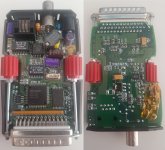I am trying to connect my Sharp PC-3000 palmtop to my network using a Xircom PE3-10BC pocket ethernet adapter by connecting it to the computer's parallel port. I'm having a problem when I run the PE3TEST.EXE diagnostic program it displays the error "Adapter address EEPROM unreadable". This does show that the adapter is detected though, as there is a different error message if you run the program without an adapter present.
The adapter is connected via a wall plug and the status light glows green when there is an ethernet cable attached, and red when unplugged. So it doesn't appear that the adapter is entirely dead.
The only thing which is a bit odd in my setup: the Sharp PC-3000 has a proprietary miniature parallel port. The only cable I have for it has a Centronic 36-pin male port on the end that looks like this. I assume this cable was originally intended to be plugged straight into a printer or something. I bought an adapter that has a female Centronics connector on one side and a standard female DB-25 on the other. The label on it says 'RS232 CENTRONIC GENDER CHANGER'. Does anyone know if perhaps this could be causing a problem?
Unfortunately I have no other machines with a parallel port to test the Xircom adapter with. I see that you can buy USB to DB-25 cables, so maybe there is a way I can use one of those to test the adapter via DOSBOX? I also have no other parallel port peripherals to test if there is a problem with the Centronics connector. Anyone have any ideas for a cheap and easy way of testing a parallel port?
Any suggestions?
The adapter is connected via a wall plug and the status light glows green when there is an ethernet cable attached, and red when unplugged. So it doesn't appear that the adapter is entirely dead.
The only thing which is a bit odd in my setup: the Sharp PC-3000 has a proprietary miniature parallel port. The only cable I have for it has a Centronic 36-pin male port on the end that looks like this. I assume this cable was originally intended to be plugged straight into a printer or something. I bought an adapter that has a female Centronics connector on one side and a standard female DB-25 on the other. The label on it says 'RS232 CENTRONIC GENDER CHANGER'. Does anyone know if perhaps this could be causing a problem?
Unfortunately I have no other machines with a parallel port to test the Xircom adapter with. I see that you can buy USB to DB-25 cables, so maybe there is a way I can use one of those to test the adapter via DOSBOX? I also have no other parallel port peripherals to test if there is a problem with the Centronics connector. Anyone have any ideas for a cheap and easy way of testing a parallel port?
Any suggestions?

